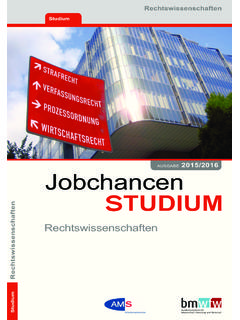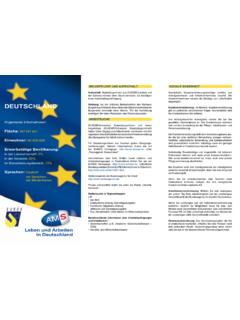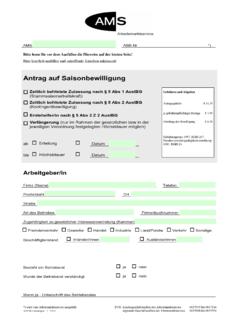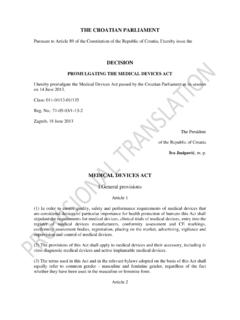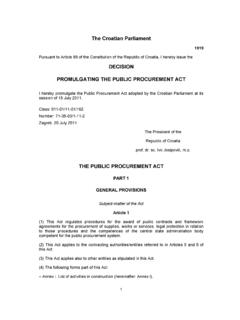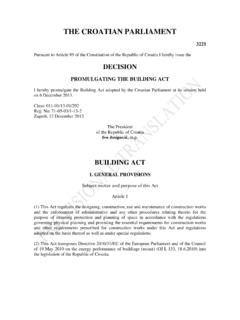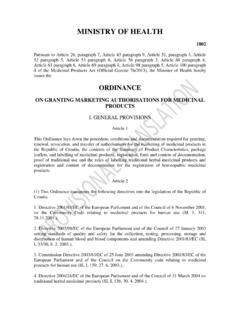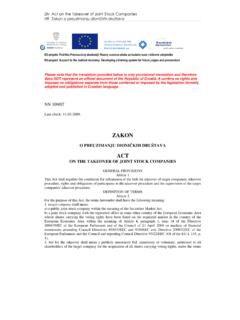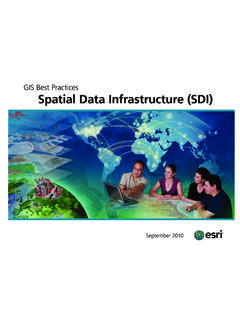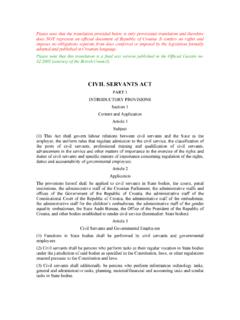Transcription of Living & Working in Austria - Startseite
1 Living & Working in AustriaLand area: 83,878 km2 Population: 8,451,860 Population in gainful employment:Agriculture: 5%Industry: 23%Services sector: 72%2 Living & Working in Austria 2014 TABLE OF CONTENTS1. GENERAL Geography and Population The Political System Climate Languages Culture & Religion Labour Market Facts & Figures 62. ARRIVING IN Austria Duty of Registration Residence Bringing Domestic and Household Pets into Austria 83. Living CONDITIONS Comparable Price Levels of Living Costs International Dialling Code Emergency Services Numbers Retail Business Hours Opening a Bank Account Motor Vehicles Driving License Motor Vehicle Licenses Housing Short-Term Accommodation in Hotels and Youth Hostels Important Details regarding Housing Finding Permanent Housing Eligibility for Council Housing (Gemeindewohnungen) Eligibility for Housing Association Accommodation (Genossenschaftswohnungen) Application for a Radio and TV License Registration for Gas and Electricity Registration of Fixed Network Phones and Mobile Phones 134.
2 SEEKING EMPLOYMENT IN Austria Seeking Employment from the EU/EEA Countries and Switzerland in Austria EURES (European Employment Services) Public Employment Service Austria (AMS) Daily Newspapers Private Recruitment Agencies Hidden Labour Market Au-pairs Seasonal Workers Transitional Stipulations Applying to Bulgarian, Croatian and Romanian Citizens on the Austrian Labour Market Applications 205. TERMS AND CONDITIONS OF EMPLOYMENT Labour Law Overview Bodies representing Employees Chamber of Labour and Austrian Trade Unions Works Council 223 Living & Working in Austria Employment Relations Employment Contract and Position Specifications Statement Working Hours and Vacation Entitlements Termination Persons Working on Short-Term Contracts as Independent Contractors Contract for Work and Labour Educational Leave and Sabbaticals Family Hospice & Filial Leaves 286. RECOGNITION OF FOREIGN DIPLOMAS & LICENSES General Examples of Regulated Professions Teachers Health Sector Medical Doctors Lawyers Architects/Construction Engineers/Civil Engineers Recognition of School and Vocational Diplomas 317.
3 Taxes Income Tax and Employee Tax Assessment 328. SOCIAL SECURITY Health Insurance Accident Insurance Pensions Insurance Unemployment Insurance Financial Benefits Unemployment Benefits from the EU/EEA States and Switzerland Receiving Unemployment Benefits from EU/EEA States and Switzerland while Seeking Employment in Austria Aggregating Insurance Periods from Employment in the EU/EEA States and Switzerland Means Tested Minimum Benefits 399. Living WITH CHILDREN Maternity Protection White and Blue Collar Employees and Minimum Income Employees Independent Female Contractors and Female Contract Assignees Self-Employed Females Mother-Child Pass Parental Leave Allowance, Childcare Allowance and Parental Leave Time Family Allowance (Familienbeihilfe) 4410. EDUCATION Education & Training Overview Initial Vocational Training Apprenticeships Further Education 4811. CHECKLIST FOR RELOCATING TO Austria 4912.
4 EUROPEAN EMPLOYMENT SERVICE (EURES) ADVISERS IN Austria 514 Living & Working in Austria 20141. GENERAL Geography & PopulationAustria covers an area of 83,878 square kilometres with a population of 8,451,860 residents, (as of 2013) including 1,004,268 foreign citizens ( of total population). Vienna is the most densely populated province of Austria with 4,199 residents per square kilometre; Tyrol is the least densely populated province with 57 inhabitants per square kilometre (population as of 2013). The average new-born life expectancy in 2012 is 81 years. Austria is bordered by Switzerland, Liechtenstein, Germany, the Czech Republic, Slovakia, Hungary, Slovenia and is a federal state comprised of nine provinces; each province has its own capital:ProvincePopulation 2013 Provincial CapitalPopulation 2013 Burgenland286,691 Eisenstadt13,351 Carinthia555,473 Klagenfurt95,450 Lower Austria 1,618,592St. P lten51,926 Upper Austria1,418,498 Linz191,501 Salzburg531,898 Salzburg145,871 Styria1,210,971 Graz265,778 Tyrol715,888 Innsbruck122,458 Vorarlberg372,603 Bregenz28,072 Vienna1,741,246 Vienna1,741, RepublikDeutschlandNIEDER STERREICHWIENOBER STERREICHSTEIERMARKK RNTENBURGEN-LANDSALZBURGTIROLVORARL-BERG STERREICHK lagenfurtLienzSanktP ltenWienSalzburgInnsbruckLiechtensteinBr egenzGrazEisenstadtLinz5 Living & Working in Austria The Political SystemAustria is a democratic republic.
5 The Federal President of Austria is the supreme representative of the state. They represent the Republic of Austria abroad in addition to other duties (acting as Supreme Commander of the Austrian Armed Forces, appointing the Federal Government as well as high-ranking officials of the provinces and concluding international agreements, etc.).The legislative body of Austria is the Parliament, which consists of two houses, the National Council (Nationalrat) and the Federal Council (Bundesrat). The Federal Government is headed by the Federal Chancellor who conducts governmental affairs with the assistance of the Vice-Chancellor, federal cabinet ministers and state province is administered by its own government, headed by a provincial Governor (Landes-hauptmann/Landeshauptfrau). Austria has been a member of the European Union since 1995. ClimateAustria has a typical central European transitional climate (warm summers, cold winters and adequate precipitation).
6 Additionally there are two distinct climatic zones in the interior regions of Austria : the east shows a Pannonian climate (warm to hot summers, relatively low precipitation and cold winters), while the central Alpine region has the characteristic features of the Alpine climate (as compared to the east, more precipitation in summer and long winters with heavy snowfall). LanguagesGerman is the official language of Austria and thus a prerequisite for participating in the Working and economic life of the country. Croatian, Slovenian and Hungarian are recognised as official languages in the individual regions of autonomous population groups. English is taught at school as the first foreign language. Culture & ReligionVarious clubs and associations (football, auxiliary fire brigade, singing clubs, etc.) exist in Austria in most of the smaller towns (municipalities). There are comprehensive cultural facilities (theatre, cinema, arts expositions) and manifold sports facilities in the larger towns and cities.
7 Information on clubs and associations can be obtained from the municipal offices and authorities (town and municipal administrative authorities). Daily newspapers and special event calendars provide information on current cultural East of Austria (Vienna, Lower Austria , Burgenland, Styria) has traditionally strong links to the neighbouring countries (the Czech Republic, Slovakia, Hungary, Slovenia). Today this proximity to Austria is expressed amongst others through reciprocal economic activities in these countries. The influences of former monarchical provinces can also be found in Austrian cuisine. In smaller settlements, you will find inns and taverns with Austrian specialities (Wiener schnitzel, etc.) and typical regional dishes. In towns and larger villages there are restaurants offering international cuisine; Italian and Asian restaurants are particularly popular. Meals are served as follows: breakfast between 8 and 10 am; lunch between am and 2 pm; dinner between 6 and 8 pm.
8 In rural regions sometimes only small snacks are served outside the regular serving times. In built-up areas and large cities there are numerous restaurants offering warm dishes throughout the & Working in Austria 2014 Austrian culture is heavily influenced by the Catholic Church. As of 2011 the majority of the Austrian population is catholic (70%), followed by protestants ( ), Muslims (4%) and Orthodox Christians (2%). A large group of people Living in Austria are agnostics (11%). (Statistics Austria ) (Austrian Federal Chancellery) Labour Market Facts & FiguresIn the third quarter of 2013 (July September) an average of 4,023,100 people were in gainful employment; of which 2,256,100 were male and 1,974,600 female. The quota of 15 year-old and older employed persons, the share of the employed persons in all persons in this age group was at percent in 2013. The part-time employment quota (share of persons Working less than 36 hours a week according to information provided by them) amounts to percent in 2012.
9 The share of female part-time employment lies at percent. The number of unemployed recorded in the 3rd quarter of 2013 was 260,280. This represents an unemployment quota of percent (national computation formula) respectively percent (according to the EU definition of unemployment quota not seasonally adjusted). The unemployment quota according to national computation amounts to percent in the third quarter of youth unemployment quota (15 to 24 years old) is percent (national computation) whereas the unemployment quota of elderly people (55 to 64 years old) is percent. Non-Austrian citizens are particularly affected by unemployment (9 percent).When comparing the provinces unemployment in the third quarter of 2013 is highest in Vienna with an average of percent and lowest in Salzburg with (employment status (Erwerbsstatus)) (part-time employment quota (Teilzeitquote)) (unemployment (Arbeitslosigkeit)) Living & Working in Austria 201472 ARRIVING IN Duty of RegistrationResidential registration is mandatory in Austria .
10 Any person establishing their residence in Austria is obliged to register with the respective competent authority within three (3) days of establishing the authorities to contact in this regard are: the registration office of the municipality office (Gemeindeamt) or the municipal authorities (Magistrat) in cities in Vienna: the registration office of the municipal district offices (Magistratische Bezirks mter)The following documents are to be furnished: completed registration form for each person to be registered; the registration form can be obtained from the responsible registration authorities, registry offices ( in Vienna) or the Internet. passport and birth certificate residence registration certificates for any other places of residenceThe residence registration form (previously residence registration certificate, Meldezettel) must be signed by the lessee (the owner or the property management) and the tenant, submitted personally or by a person of trust or sent by post to the responsible residence registration authorities (Meldebeh rde).

